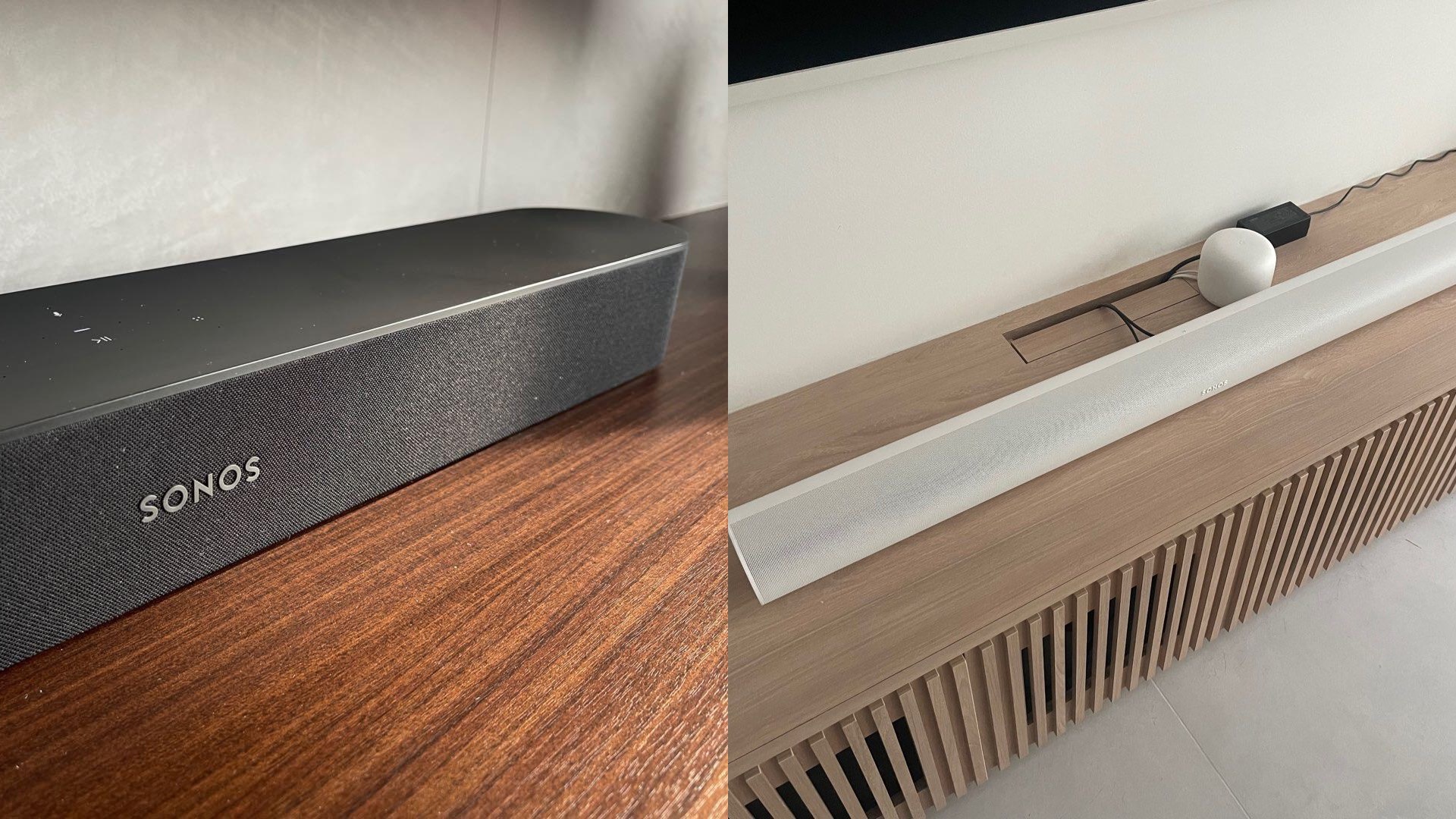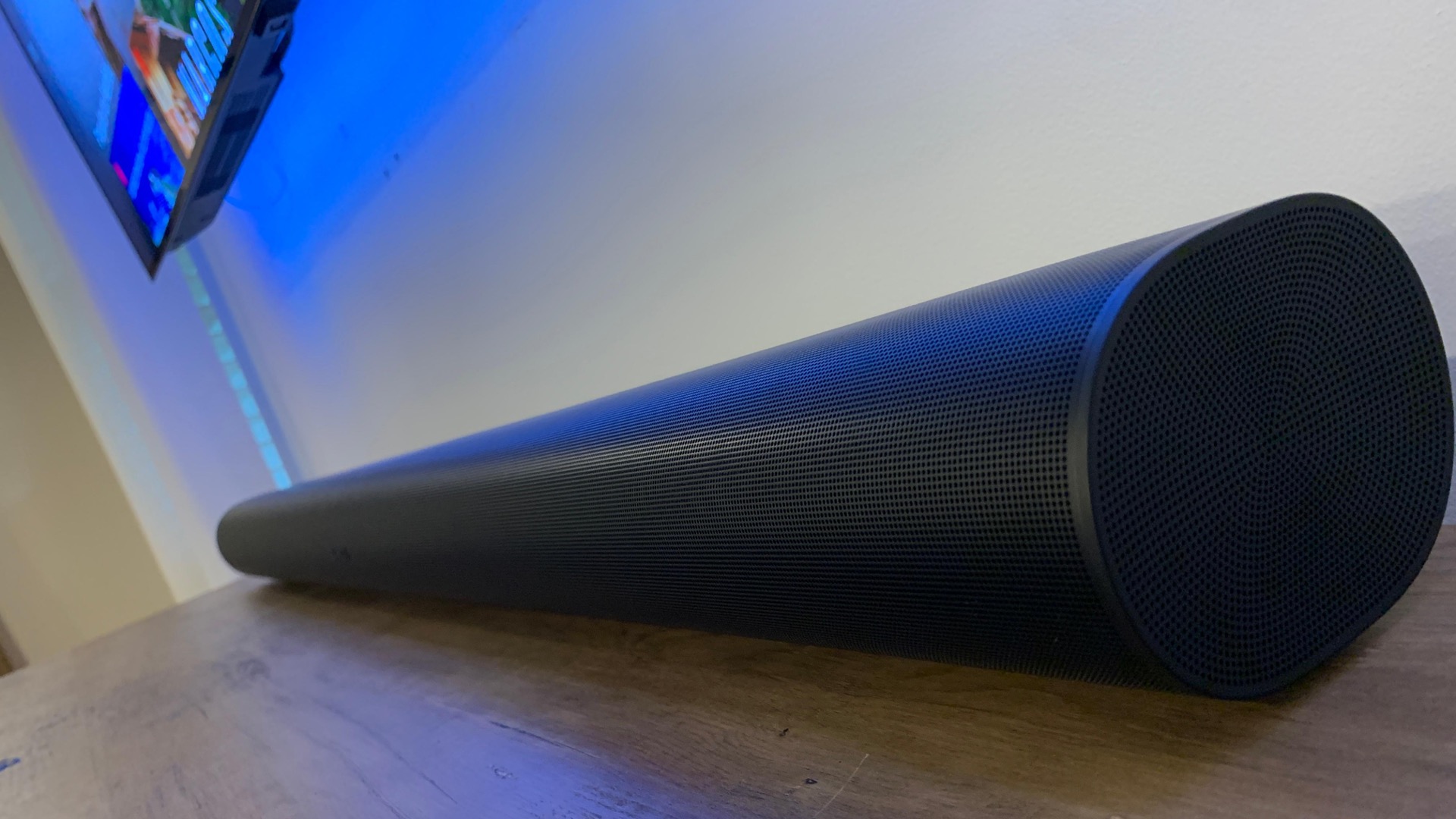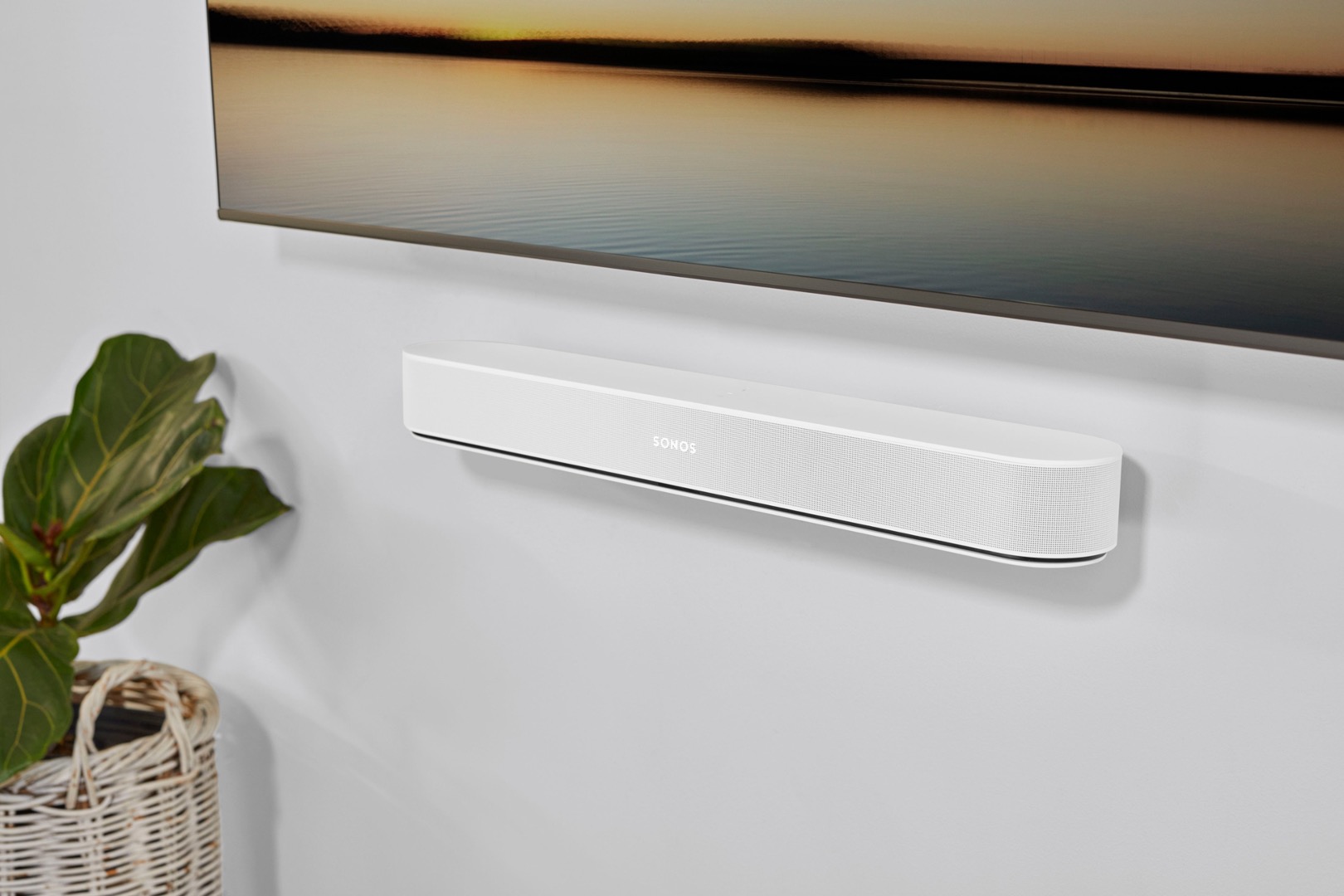The Sonos Arc and Sonos Beam (Gen 2) are both really powerful soundbars from Sonos. The Sonos Beam (Gen 2) is the latest soundbar released by Sonos on October 21 and replaces the Sonos Beam (Gen 1) soundbar. We tested both soundbars to see which one delivers better sound performance in a living room setting, and we found that the Sonos Arc delivered better spatial sound performance for movies and sound effects while the Sonos Beam (Gen 2) provides crisp stereo sound with its frontal speaker drivers.
Compared with the Sonos Beam (Gen 2), the Sonos Arc is a larger, more powerful soundbar designed for use with bigger TVs and in larger rooms. It features up-firing drivers and provides a wider soundstage and more room-filling performance, making it well-suited for Dolby Atmos content. On the other hand, the Sonos Beam (Gen 2) is a more compact and affordable option, making it suitable for smaller TVs and rooms. While it lacks the up-firing drivers of the Arc, it still handles Dolby Atmos effectively and is a more budget-friendly choice especially if you want to listen to music in stereo mode.

Comparing the Specs
| Specification | Sonos Arc | Sonos Beam (Gen 2) |
| Configuration | 5.0.2 | 5.0 |
| Upward Firing Drivers | 2 | No |
| Amplifier | 11 Class-D amps | 5 Class-D digital amps |
| Woofers | 8 full-range woofers | 4 full-range woofers |
| Tweeters | 3 tweeters | 1 tweeter |
| Microphone | 4 microphone array | 5 far-field microphone array |
| Network Connections | Ethernet, Wi-Fi (802.11b/g/n – 2.4GHz), Apple AirPlay 2 | Ethernet, Wi-Fi (802.11 b/g/n/ac – 2.4 or 5 GHz), Apple AirPlay 2 |
| Supported Home Theater Audio Formats | Dolby Digital Plus (+ Dolby Atmos), Dolby TrueHD (+ Dolby Atmos), DTS, Multichannel LPCM, Dolby Digital 5.1, Stereo PCM | Dolby Digital Plus (+ Dolby Atmos), Dolby TrueHD (+ Dolby Atmos), DTS, Multichannel LPCM, Dolby Digital 5.1, Stereo PCM |
| Top Panel Control Features | Capacitive touch control for volume, track control, play/pause, microphone mute, status LED | Capacitive touch control for volume, track control, play/pause, microphone mute, status LED |
| Voice Control | Alexa, Google Assistant, Siri | Alexa, Google Assistant, Siri |
| Accessories | Power cable, HDMI cable, optical audio adapter | Power cable, HDMI cable, optical audio adapter |
| Dimensions (W x H x D) | 45 x 3.4 x 4.5 inches | 25.63 x 2.7 x 3.94 inches |
| Wall-Mountable? | Yes, with a dedicated wall mount kit | Yes, with a dedicated wall mount kit |
The main difference between the Sonos Arc and the Sonos Beam (Gen 2) is that the Sonos Arc comes with two upward firing speakers for sound effects, while the Sonos Beam (Gen 2) only has front tweeters and woofers (the Sonos beam is better for stereo listening while the Arc has better spatial sound effects). The Sonos Arc has a wider sound field compared with the Sonos Beam (Gen 2), and is powered by 11 Class D amplifiers compared with the Sonos Beam (Gen 2)’s 5 Class-D amps.

Sound Performance Comparison
In terms of sound performance, the Sonos Arc delivers a wider sound field and immersive experience compared with the Sonos Beam (Gen 2), particularly for Dolby Atmos content. It provides a more expansive and room-filling soundstage, making it ideal for creating a cinematic experience in a home theater setup. We watched a couple of movies including Batman’s The Dark Night Rises on the Sonos Arc and the sound quality was impressive with really good sound effects (you can hear footsteps walking from behind) and the Sonos Arc really emphasizes effects that you might not have noticed before. You can hear the direction of projectiles flying in the air (from left to right or vice versa) clearly, and movie dialogues sounded crisp and crystal clear. We felt that the Sonos Arc worked best when combined with a subwoofer such as the Sonos Sub for home theater.
On the other hand, the Sonos Beam (Gen 2) has a somewhat punchier sound and more direct audio delivery, which can be preferable if you like the sound to be directly projected at you especially in smaller spaces.
The Sonos Arc comes with a total of 8 woofers and 3 tweeters, which include 4 woofers aimed directly at the listener and 2 drivers aimed upwards to enhance the Dolby Atmos experience. This configuration provides a more immersive and spacious sound, and sounds best in larger rooms or for more expansive home theater setups.
On the other hand, the Beam (Gen 2) features a center tweeter, 4 woofers, and 3 passive bass radiators. While it also supports Dolby Atmos, the Beam’s sound is more focused and less expansive compared to the Arc, making it better for smaller rooms or if you prefer listening to music without spatial audio.
We would say that the Sonos Arc has the ability to distribute volume a lot wider, and movie sound effects like the splashing of water or sound of the wind sounded spacious and wider. We did feel that the Sonos Beam (Gen 2) delivered sound that was more ‘in your face’ and direct; the Beam felt a lot punchier and the bass felt somewhat deeper than the Sonos Arc especially in smaller rooms. Because of this sound distribution, you may find the Sonos Beam (Gen 2) slightly louder and clearer at the same volume compared to the Sonos Arc if you are standing in front of the soundbar.
Having said that, we still preferred the overall sound quality of the Sonos Arc because it has both a wider sound field and upward firing speakers for Dolby Atmos sound effects (this makes a huge difference if like to watch Dolby Atmos content and movies). The Beam 2 is a good speaker in its own right but has a less expansive sound field and lacks any upward firing speaker, so while it can interpolate Dolby Atmos signals to a 5.0 configuration, the Beam 2 cannot reproduce a 3D spatial audio image like the Sonos Arc.
Overall, the Beam 2 will be a pretty solid option if you want to get a speaker a smaller room. We would recommend the Sonos Arc if you want to get a speaker for a large living room space with Sonos home theater setup.
Read also: Sonos Arc vs Bose 900 Soundbar: Which sounds better?
Specifications and Features
Both the Arc and Beam (Gen 2) support a wide range of home theater audio formats, including Dolby Digital Plus (+ Dolby Atmos), Dolby TrueHD (+ Dolby Atmos), DTS, Multichannel LPCM, Dolby Digital 5.1, and Stereo PCM. This means that you can use both the Sonos Arc and the Sonos Beam (Gen 2) for watching movies and they will deliver really nice sound effects. That being said, the Sonos Arc edges out the Sonos Beam when watching movies with better sound effects and a more spacious sound field. Do note that for high-resolution audio, an eARC connection is required from the TV.
In terms of control, both models feature top panel capacitive touch control for volume adjustment, track control, play/pause, and microphone mute. They also include voice control capabilities with support for Amazon Alexa, Google Assistant, and Siri, offering hands-free control for various functions.

Design and Size
The Sonos Arc is significantly larger than the Beam (Gen 2), with dimensions of 1141.7 x 87 x 115.7 mm compared to the Beam’s 651 x 68.5 x 100 mm. The Arc’s larger size makes it more suitable for larger rooms and bigger TVs, while the Beam’s compact design is ideal for smaller spaces and TVs. The Sonos Arc is a better soundbar if you have a large TV, while the Sonos Beam 2 is more suited for compact and smaller spaces.
Home Theater Use Cases
The Sonos Arc is a great choice if you need a soundbar for a larger room – the Arc has 11 Class-D amplifiers which is double that of the Sonos Beam 2 (it only has 5 amps). Because the Sonos Arc has more tweeters and woofers than the Beam 2, it creates a more enveloping sound which particularly effective for movies and content with complex soundscapes.
The Sonos Beam (Gen 2) is more suited for small to medium-sized rooms and has a more “straight-forward” sound. While the Sonos Beam 2 may sound punchier at first impression, the Sonos Arc has a more spacious sound that can be complemented with the Sonos Sub for much deeper bass.
The Verdict?
We preferred the Sonos Arc soundbar because it has a much wider listening field, upward firing tweeters and more Class-D amps than the Beam 2. Throughout our listening tests, we felt that the Sonos Arc delivered a much wider soundstage and better Dolby Atmos sound effects (we rewatched Batman The Dark Night Rises on this soundbar) and it sounded absolutely phenomenal especially when paired with a Sonos subwoofer. It feels like you are sitting in a real life Dolby Atmos theater with really spacious sound performance. While the Sonos Beam 2 does deliver really punchy sound and also supports Dolby Atmos, it does not have a wide listening field like the Sonos Arc and they sound less immersive than the Sonos Arc when watching movies. It’s a soundbar that’s more suited for smaller and compact spaces or for casual music listening. With that said, we still preferred the Sonos Arc because if you do add a subwoofer (such as the Sonos Sub Gen 3) to the entire system, the punchier bass on the Sonos Beam 2 will still be negated by the Sonos Sub while the sound on the Sonos Arc will feel much more spacious with its upward firing tweeters.

